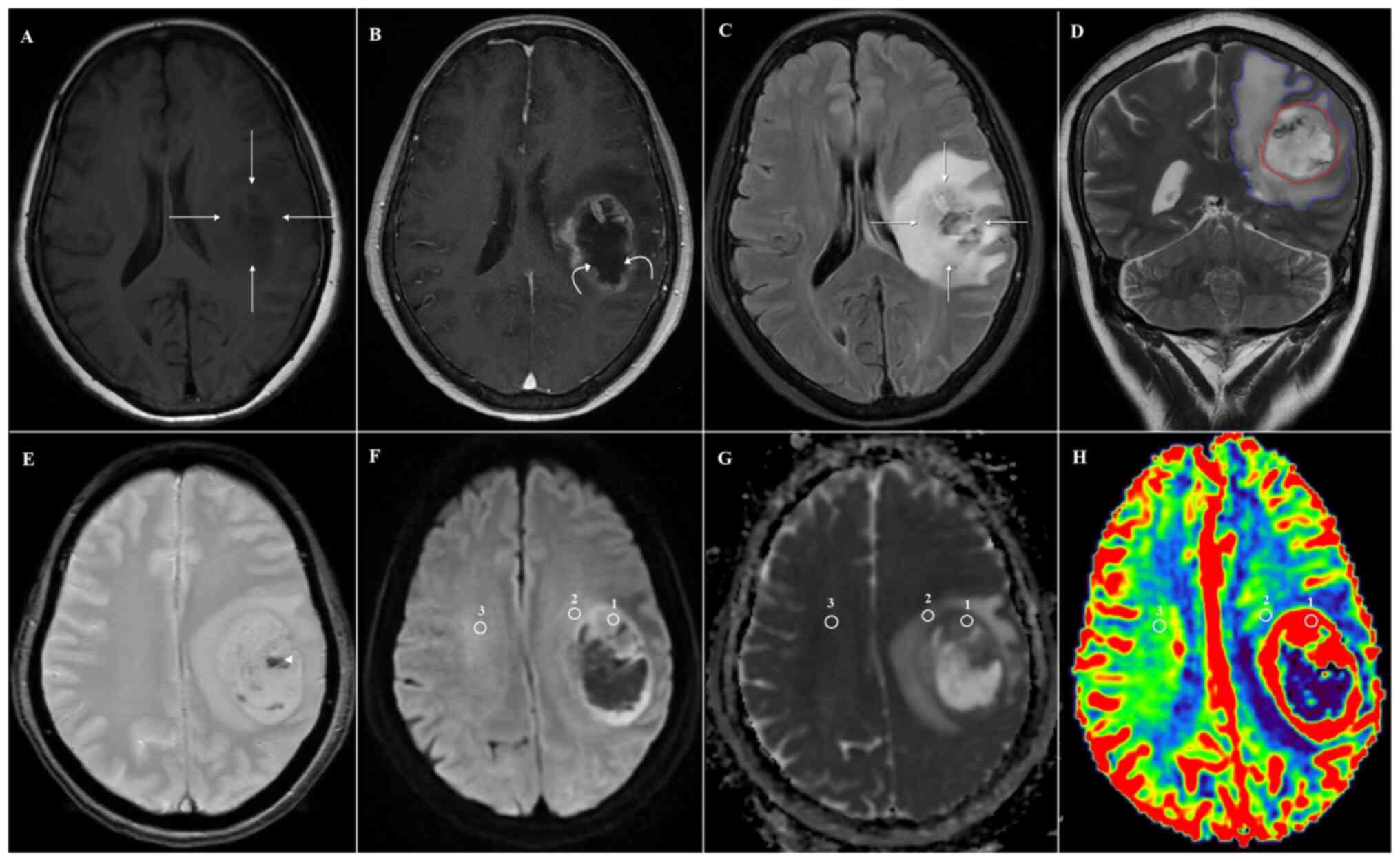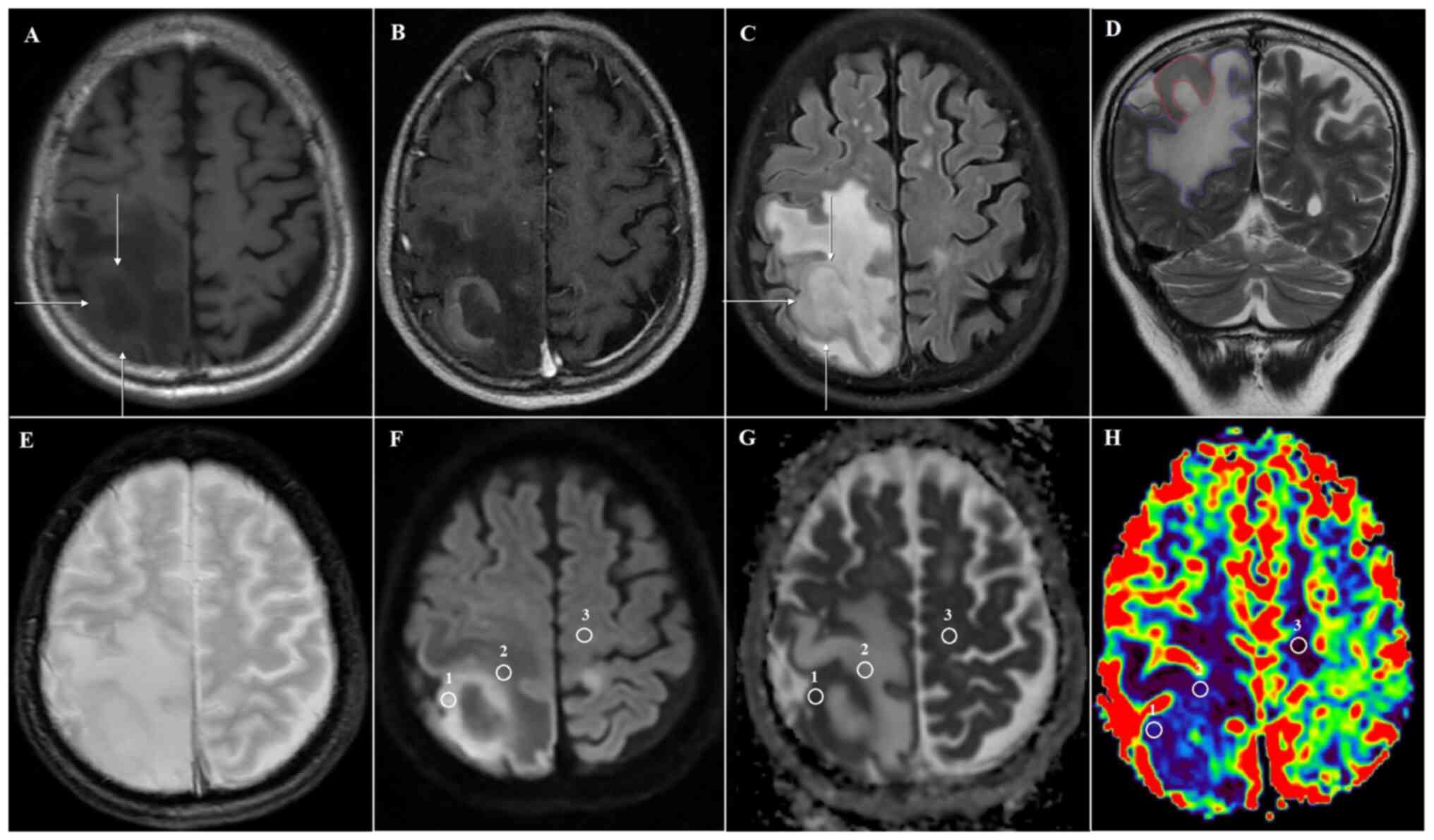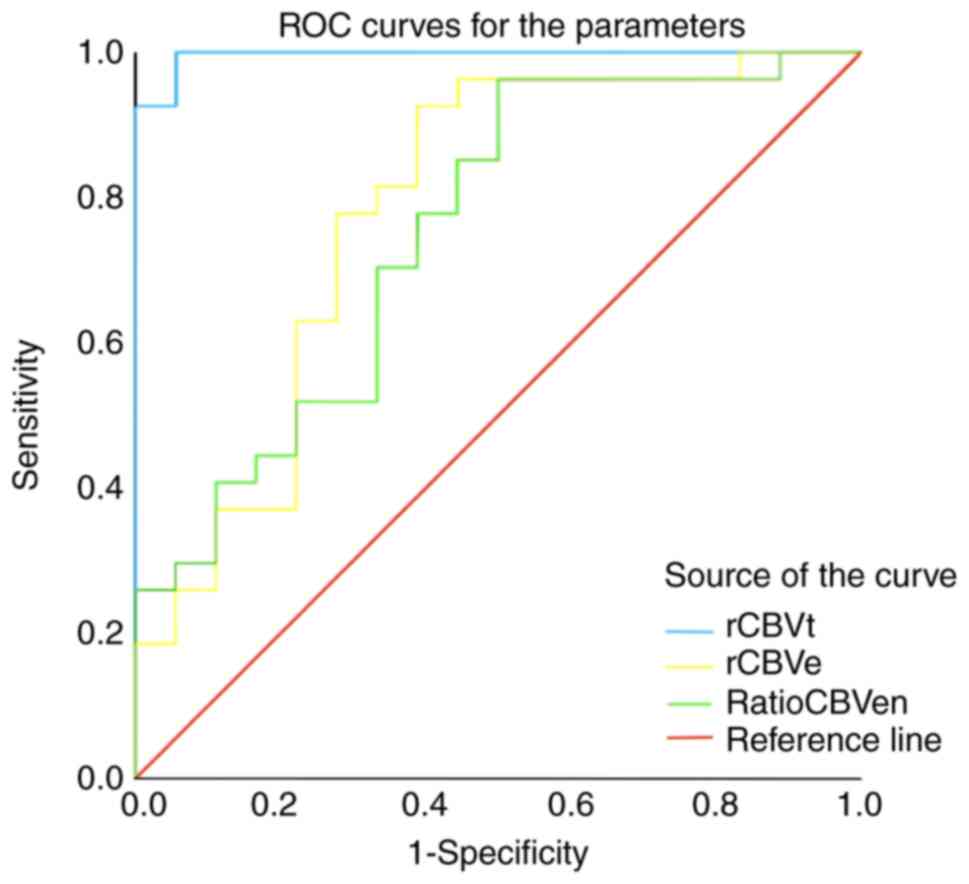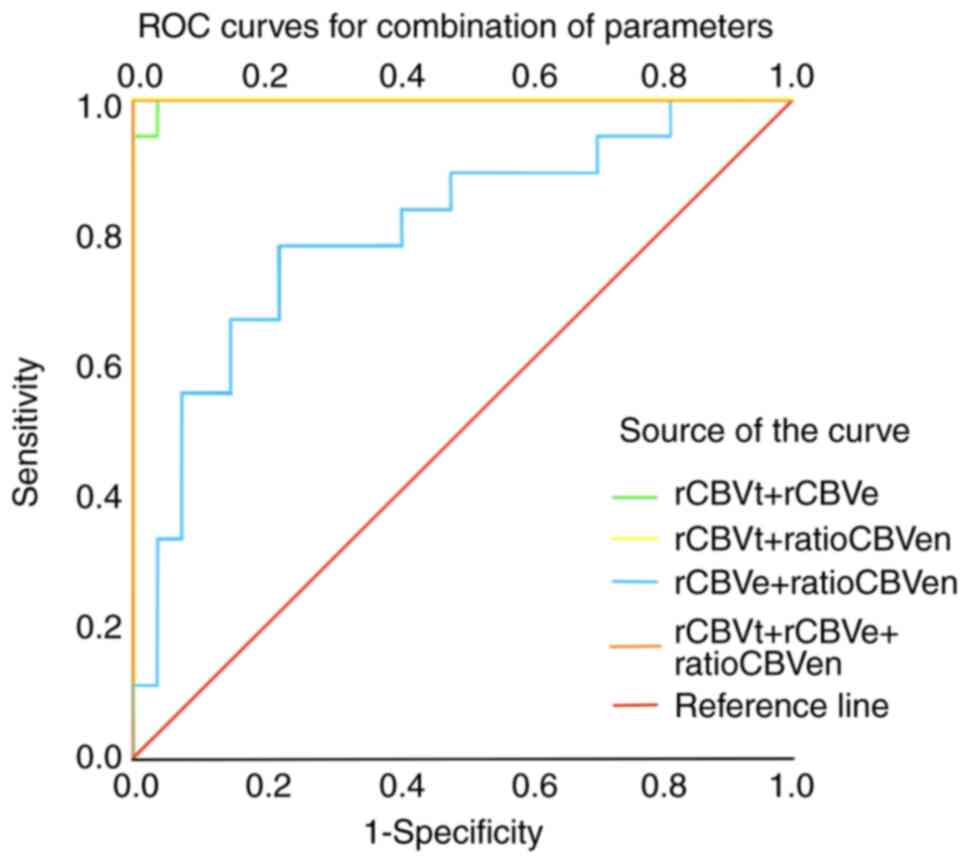|
1
|
Hanif F, Muzaffar K, Perveen K, Malhi SM
and Simjee SU: Glioblastoma multiforme: A review of its
epidemiology and pathogenesis through clinical presentation and
treatment. Asian Pac J Cancer Prev. 18:3–9. 2017.PubMed/NCBI View Article : Google Scholar
|
|
2
|
Salacz ME, Watson KR and Schomas DA:
Glioblastoma: Part I. Current state of affairs. Mo Med.
108:187–194. 2011.PubMed/NCBI
|
|
3
|
Lee SC, Moon WJ, Choi JW, Roh HG, Bak SH,
Yi JG, Yim YJ and Chung EC: Differentitation between primary
central nervous system lymphoma and glioblastoma: Added value of
quantitative analysis of CT attenuation and apparent diffusion
coefficient. J Korean Soc Magn Reson Med. 16:226–235. 2012.
|
|
4
|
Tang YZ, Booth TC, Bhogal P, Malhotra A
and Wilhelm T: Imaging of primary central nervous system lymphoma.
Clin Radiol. 66:768–777. 2011.
|
|
5
|
Konjević G, Jurisić V, Banićevic B and
Spuzić I: The difference in NK-cell activity between patients with
non-Hodgkin's lymphomas and Hodgkin's disease. Br J Haematol.
104:144–151. 1999.PubMed/NCBI View Article : Google Scholar
|
|
6
|
Jurišić V, Konjević G, Banićević B,
Duricić B and Spuzić I: Different alterations in lactate
dehydrogenase activity and profile of peripheral blood mononuclear
cells in Hodgkin's and non-Hodgkin's lymphomas. Eur J Haematol.
64:259–266. 2000.PubMed/NCBI View Article : Google Scholar
|
|
7
|
Han CH and Batchelor TT: Diagnosis and
management of primary central nervous system lymphoma. Cancer.
123:4314–4324. 2017.PubMed/NCBI View Article : Google Scholar
|
|
8
|
Urbańska K, Sokołowska J, Szmidt M and
Sysa P: Glioblastoma multiforme-an overview. Contemp Oncol (Pozn).
18:307–312. 2014.PubMed/NCBI View Article : Google Scholar
|
|
9
|
Mizobuchi Y, Nakajima K, Fujihara T,
Matsuzaki K, Mure H, Nagahiro S and Takagi Y: The risk of
hemorrhage in stereotactic biopsy for brain tumors. J Med Invest.
66:314–318. 2019.PubMed/NCBI View Article : Google Scholar
|
|
10
|
Vaquero J, Martínez R and Manrique M:
Stereotactic biopsy for brain tumors: Is it always necessary? Surg
Neurol. 53:432–437. 2000.PubMed/NCBI View Article : Google Scholar
|
|
11
|
Han Y, Wang ZJ, Li WH, Yang Y, Zhang J,
Yang XB, Zuo L, Xiao G, Wang SZ, Yan LF and Cui GB: Differentiation
between primary central nervous system lymphoma and atypical
glioblastoma based on MRI morphological feature and signal
intensity ratio: A retrospective multicenter study. Front Oncol.
12(811197)2022.PubMed/NCBI View Article : Google Scholar
|
|
12
|
Kickingereder P, Wiestler B, Sahm F,
Heiland S, Roethke M, Schlemmer HP, Wick W, Bendszus M and Radbruch
A: Primary central nervous system lymphoma and atypical
glioblastoma: Multiparametric differentiation by using diffusion-,
perfusion-, and susceptibility-weighted MR imaging. Radiology.
272:843–850. 2014.PubMed/NCBI View Article : Google Scholar
|
|
13
|
Kono K, Inoue Y, Nakayama K, Shakudo M,
Morino M, Ohata K, Wakasa K and Yamada R: The role of
diffusion-weighted imaging in patients with brain tumors. AJNR Am J
Neuroradiol. 22:1081–1088. 2001.PubMed/NCBI
|
|
14
|
Aronen HJ, Gazit IE, Louis DN, Buchbinder
BR, Pardo FS, Weisskoff RM, Harsh GR, Cosgrove GR, Halpern EF and
Hochberg FH: Cerebral blood volume maps of gliomas: Comparison with
tumor grade and histologic findings. Radiology. 191:41–51.
1994.PubMed/NCBI View Article : Google Scholar
|
|
15
|
Neska-Matuszewska M, Bladowska J, Sąsiadek
M and Zimny A: Differentiation of glioblastoma multiforme,
metastases and primary central nervous system lymphomas using
multiparametric perfusion and diffusion MR imaging of a tumor core
and a peritumoral zone-Searching for a practical approach. PLoS
One. 13(e0191341)2018.PubMed/NCBI View Article : Google Scholar
|
|
16
|
Feng A, Li L, Huang T, Li S, He N, Huang
L, Zeng M and Lyu J: Differentiating glioblastoma from primary
central nervous system lymphoma of atypical manifestation using
multiparametric magnetic resonance imaging: A comparative study.
Heliyon. 9(e15150)2023.PubMed/NCBI View Article : Google Scholar
|
|
17
|
Bao S, Watanabe Y, Takahashi H, Tanaka H,
Arisawa A, Matsuo C, Wu R, Fujimoto Y and Tomiyama N:
Differentiating between glioblastoma and primary CNS lymphoma using
combined whole-tumor histogram analysis of the normalized cerebral
blood volume and the apparent diffusion coefficient. Magn Reson Med
Sci. 18:53–61. 2019.PubMed/NCBI View Article : Google Scholar
|
|
18
|
Makino K, Hirai T, Nakamura H, Kuroda JI,
Shinojima N, Uetani H, Kitajima M and Yano S: Differentiating
between primary central nervous system lymphomas and glioblastomas:
Combined use of perfusion-weighted and diffusion-weighted magnetic
resonance imaging. World Neurosurg. 112:e1–e6. 2018.PubMed/NCBI View Article : Google Scholar
|
|
19
|
Nakajima S, Okada T, Yamamoto A, Kanagaki
M, Fushimi Y, Okada T, Arakawa Y, Takagi Y, Miyamoto S and Togashi
K: Differentiation between primary central nervous system lymphoma
and glioblastoma: A comparative study of parameters derived from
dynamic susceptibility contrast-enhanced perfusion-weighted MRI.
Clin Radiol. 70:1393–1399. 2015.PubMed/NCBI View Article : Google Scholar
|
|
20
|
Abul-Kasim K, Maly P, Strömbeck A,
Svensson J and Sundgren PC: Perfusion weighted MR imaging may
differentiate primary CNS lymphoma from other homogeneously
enhancing brain tumors. Neuroradiol J. 21:637–644. 2008.PubMed/NCBI View Article : Google Scholar
|
|
21
|
Ko CC, Tai MH, Li CF, Chen TY, Chen JH,
Shu G, Kuo YT and Lee YC: Differentiation between glioblastoma
multiforme and primary cerebral lymphoma: Additional benefits of
quantitative diffusion-weighted MR imaging. PLoS One.
11(e0162565)2016.PubMed/NCBI View Article : Google Scholar
|
|
22
|
Osborn AG, Louis DN, Poussaint TY,
Linscott LL and Salzman KL: The 2021 world health organization
classification of tumors of the central nervous system: What
neuroradiologists need to know. AJNR Am J Neuroradiol. 43:928–937.
2022.PubMed/NCBI View Article : Google Scholar
|
|
23
|
Das S and Marsden PA: Angiogenesis in
glioblastoma. N Engl J Med. 369:1561–1563. 2013.PubMed/NCBI View Article : Google Scholar
|
|
24
|
Lugano R, Ramachandran M and Dimberg A:
Tumor angiogenesis: Causes, consequences, challenges and
opportunities. Cell Mol Life Sci. 77:1745–1770. 2020.PubMed/NCBI View Article : Google Scholar
|
|
25
|
Zhang D, Hu LB, Henning TD, Ravarani EM,
Zou LG, Feng XY, Wang WX and Wen L: MRI findings of primary CNS
lymphoma in 26 immunocompetent patients. Korean J Radiol.
11:269–277. 2010.PubMed/NCBI View Article : Google Scholar
|
|
26
|
Malikova H, Koubska E, Weichet J, Klener
J, Rulseh A, Liscak R and Vojtech Z: Can morphological MRI
differentiate between primary central nervous system lymphoma and
glioblastoma? Cancer Imaging. 16(40)2016.PubMed/NCBI View Article : Google Scholar
|
|
27
|
Osborn AG, Salzman KL and Jhaveri MD
(eds): Diagnostic Imaging Brain. 3rd edition. Elsevier,
Philadelphia, PA, 2016.
|
|
28
|
Haldorsen IS, Kråkenes J, Krossnes BK,
Mella O and Espeland A: CT and MR imaging features of primary
central nervous system lymphoma in Norway, 1989-2003. AJNR Am J
Neuroradiol. 30:744–751. 2009.PubMed/NCBI View Article : Google Scholar
|
|
29
|
Yamashita K, Yoshiura T, Hiwatashi A,
Togao O, Yoshimoto K, Suzuki SO, Abe K, Kikuchi K, Maruoka Y,
Mizoguchi M, et al: Differentiating primary CNS lymphoma from
glioblastoma multiforme: assessment using arterial spin labeling,
diffusion-weighted imaging, and 18F-fluorodeoxyglucose
positron emission tomography. Neuroradiology. 55:135–143.
2013.PubMed/NCBI View Article : Google Scholar
|
|
30
|
Server A, Kulle B, Maehlen J, Josefsen R,
Schellhorn T, Kumar T, Langberg CW and Nakstad PH: Quantitative
apparent diffusion coefficients in the characterization of brain
tumors and associated peritumoral edema. Acta Radiol. 50:682–689.
2009.PubMed/NCBI View Article : Google Scholar
|
|
31
|
Martín-Noguerol T, Mohan S,
Santos-Armentia E, Cabrera-Zubizarreta A and Luna A: Advanced MRI
assessment of non-enhancing peritumoral signal abnormality in brain
lesions. Eur J Radiol. 143(109900)2021.PubMed/NCBI View Article : Google Scholar
|
|
32
|
Koeller KK, Smirniotopoulos JG and Jones
RV: Primary central nervous system lymphoma: Radiologic-pathologic
correlation. Radiographics. 17:1497–1526. 1997.PubMed/NCBI View Article : Google Scholar
|
|
33
|
Lasocki A and Gaillard F:
Non-contrast-enhancing tumor: A new frontier in glioblastoma
research. AJNR Am J Neuroradiol. 40:758–765. 2019.PubMed/NCBI View Article : Google Scholar
|


















